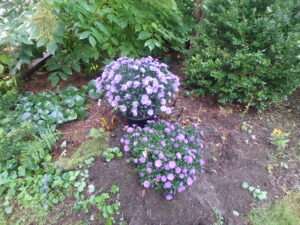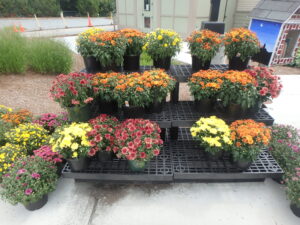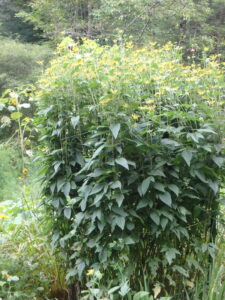Do You Deserve a Medal?
Posted on Wednesday, September 1, 2021 · Leave a Comment
As I walked around the garden recently with my wife, Cindy Heath, she turned to me and said, ”Anybody whose gardens looks great at this time of year deserves a medal.” I allowed that we did not deserve a medal. Wanna get the medal? Here are some tips I have come up with.
First, pull any tall weeds. By now a few vigorous weeds can tower over flowers in your garden if you let them. Pull them before company comes if you don’t want to be embarrassed by your sloth.

Pull tall weeds like touch-me-nots to make the garden look better
I have lots of jewel weed (Impatiens capensis) in partly sunny to shady flower beds that have rich, moist soil. It is a native plant, but one that can take over if you let it. I recently removed some that was well over six-feet tall. It was in a bed with tall perennials, and I guess it outgrew them to get more sunshine, In other places, where the completion is minimal, it might only get 3- or 4-feet tall.
According to the US Forest Service website, it is one of just a few native plants that can outcompete garlic mustard, a terrible invasive in our woodlands. So if you have it, and have garlic mustard, you might want to let it survive – and enjoy its bright orange and red flowers that I find cheery.
Next on my list, I’d recommend deadheading flowers that have gone by and are looking shabby. I have a huge bed of Shasta daisies in front of our house, but they were in their prime a couple of weeks ago. Cindy cleaned up the flowers with a pair of scissors in just 10 minutes. It made a huge difference to remove all those spent blossoms. There are still many flowers in that bed that look fine, so we didn’t need to cut it all down.
Bleeding heart is a favorite flower of mine. It’s a big plant that blooms in early summer in either pink or white. But by now the flowers are long gone, and the leaves have turned yellow. What to do? Cut back the foliage to the ground. Don’t wait until fall or frost to arrive, just cut it back now. Do the same throughout the garden.

Fall asters can be used to add color where you have cut back faded perennials
So what can you do with those empty spaces where you cut back flowers that have declined to the point that they needed to be cut back? Depending on the spacing, you might be able to fit in some chrysanthemums or fall asters. These are sold in bud or bloom in pots in grocery stores, farm stands and garden centers. They will bloom for weeks so long as you do not let them dry out. Fall asters are in the same category as the more common mums: inexpensive and lovely for filling in empty places.
Fall mums and short purple asters are often sold in compressed cardboard pots. Unfortunately, these dry out very quickly. If you leave the plant in them, you need to soak the pots and plants regularly, generally more than once a week. The solution? Plant them in the ground when you can, or put them into plastic, fiberglass or ceramic pots.

Chrysanthemums are nice fall annuals that will add color to your garden. They are readily available.
I can’t plant mums where I’ve cut back that big bleeding heart, for example as I would damage the roots if I dug there. But I can place them in a nice ceramic pot and set it gently in the same area as the bleeding heart, though perhaps a little forward or back from the stubs of the stems. Yes, it is work to do so, but it is worth the effort if you have it in a prominent spot that you (and your visiting friends and neighbors) will see.
In the vegetable garden many plants are suffering from a variety of fungal diseases. Mold and mildew are common and make leaves ugly. The solution? Cut off the leaves. There are usually newer, undamaged leaves, and new leaves on things like squash and pumpkins are still growing. Once a leaf has mildew, you can’t make it look good, so get rid of it.

Henry Eiler rudbeckia was tied up twice to keep it from flopping
Tall flowers are flopping over now, particularly if we get a heavy rain. I grow a black-eyed Susan, Rudbeckia ‘Henry Eiler’ that has gorgeous, unusual blossoms, but it grows to be over 6 feet tall. I surrounded the big clump with hardwood stakes a month ago and tied string from stake to stake to support it. Recently I tied another tier of string higher up on the 6-foot stakes to prevent flopping.
For some things I can avoid using string by pushing stakes into the soil at roughly a 45-degree angle, two of them in an “X” pattern. I push the flopper up then support it with the two stakes. For smaller things I use bamboo stakes, for larger, heavier things like New England asters that can by 5 feet tall, I use 5-foot one-inch hardwood stakes. Paint them green if you don’t want to notice them.

Squash leaves with disease should be cut off
What about the lawn? By Labor Day it may be looking pretty shabby. I don’t believe any of us should waste water on our lawns. If you have a sunny yard with sandy soil, your lawn may be looking yellowed and dry. Crab grass, an annual that fills in where the lawn is compacted by foot traffic, is declining or dead by now in most places. My solution? Hope for rain, and try to avoid looking at the dead spots. Enjoy looking at that medal-worthy garden of yours!







